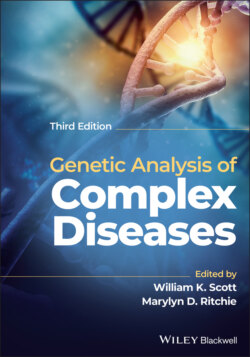Читать книгу Genetic Analysis of Complex Disease - Группа авторов - Страница 59
Introduction
ОглавлениеGenetics is believed to contribute to the etiology of almost every human trait and condition. Even for infectious diseases that have been traditionally described as environmental, such as tuberculosis and HIV, genetic factors have been implicated either in the susceptibility to infection or in the severity of the condition (Bellamy 1998; Hill 1999; Bellamy et al. 2000; Gonzalez et al. 2001; Shields and Dell 2001). Understanding the role of genetics in disease etiology can allow development of successful therapies that improve the quality of life for affected individuals and their families. However, before embarking on expensive and labor‐intensive studies to identify the genetic factors involved in a particular condition, one should evaluate the evidence that genes contribute to that trait or condition.
For Mendelian disorders, such as sickle cell anemia, cystic fibrosis, and Duchenne muscular dystrophy, establishing a role for genetics is straightforward. These conditions have predictable, recognizable inheritance patterns, and their primary etiologies can be attributed to variations in single genes. The phenotypic expression of the condition is highly correlated with the genotype at the disease locus. For example, all individuals who carry two copies of the Hb S variant of the β‐globin gene are affected with sickle cell anemia (Neel 1949). While there is variation in the severity of the symptoms, all individuals who are homozygous for Hb S will exhibit some symptoms of the disorder. In contrast, complex disorders, such as cardiovascular disease, cancers, and psychiatric disorders, usually do not display distinct inheritance patterns. Such disorders have a significant genetic component but are caused by an intricate web of genetic and environmental interactions. As a result, establishing a role for genetics in the etiology of complex disorders can be more difficult. While the genotype at a single locus may contribute to the susceptibility to develop a condition, it is expected that other loci are involved, as well. That is, multiple loci may be interacting with each other or the environment to contribute to disease. Moreover, different loci may be contributing to disease susceptibility in different families. A classic example of a complex disease susceptibility gene is the association between the APOE locus and Alzheimer disease. Corder et al. (1993) demonstrated that individuals who carry the four allele of the APOE locus have a higher risk and earlier age of onset for late onset Alzheimer disease when compared with individuals who do not carry the four allele. Furthermore, this association is dose‐dependent. Individuals who have two copies of APOE‐4 are at greater risk for the condition than individuals who carry one copy of APOE‐4. Some Alzheimer families carry the APOE‐4 genotype and some do not. Thus, the APOE gene alone does not explain the etiology of the disease. In addition to the diminished correlation between genotype and phenotype, due to the high frequency of complex diseases in the general population, often one cannot be certain that two individuals within a family have developed the condition as a result of the same genetic liability or genetic heritability. For example, the family may exhibit bilineality (family history is present on both the maternal and paternal side). Consequently, each side of the family may contribute different genetic susceptibilities to the condition. Even in the absence of bilineality, there are complications. Some individuals in the family may express the condition as a result of exposure to an environmental insult. Therefore, it can be quite challenging to determine which family members carry the same genetic susceptibilities. For all these reasons, it is more difficult to establish a genetic basis for a complex disease than for a Mendelian disease.
However, even in the presence of such complexities, there are methods available to evaluate whether or not genetics plays an important role in the disease etiology. Those methods are the primary topic of this chapter and should be explored prior to embarking on more elaborate analyses such as genome‐wide association analyses or linkage analyses. Importantly, before considering any analysis, one must first consider study design.
